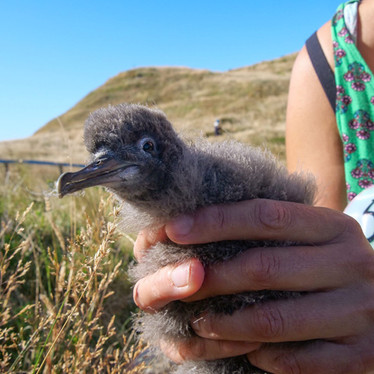
The HealthPost Nature Trust works in partnership to regenerate biodiversity in the spectacular northwest corner of Aotearoa New Zealand. Our vision, shared with Manawhenua ki Mohua and the Department of Conservation, is to create a safe environment where seabirds can once again breed safely on the cliffs, while other native species flourish in the forests and wetlands.
Bringing seabirds back to the mainland is an important step towards restoring a whole ecosystem, as their guano (bird poo) is a powerful fish-based fertiliser that nourishes the land, encouraging vegetation to thrive which in turn creates habitat for other species.
Pakahā are small, brown-and-white shearwaters often seen feeding in large flocks in the inner waters of the top half of Aotearoa, or ‘rafted up’ in dense groups to rest at sea. Pakahā burrows are very vulnerable to predation and their breeding colonies are now confined to offshore islands where pests have been eradicated.
With this knowledge, and after years of expert input and consultation, the HealthPost Nature Trust created the 3-hectare, mesh-fenced Wharariki Ecosanctuary, which incorporates the cliffs of Cape Farewell into its perimeter. The cliffs offer both important predator protection and provide the right conditions for the young seabirds to take flight. The Ecosanctuary also has several wooden ramps that the young pakahā use to help them clear the fence on the way out.
In the past two years, 106 pakahā chicks have been translocated from the Kokomohua Marine reserve in the Marlborough Sounds to the Wharariki Ecosanctuary. These chicks need to be hand-fed for 2-3 weeks on nutritious sardine smoothies (yum!) until they’re ready to head out to sea, and thanks to thousands of volunteer hours, all the chicks have fledged successfully.
The hope is that these young native birds have imprinted Cape Farewell as their new home, and will use factors such as stars, landform, and smell to identify it when it’s time to return. Pakahā tend to be faithful to the same mates and burrows for life.
Pakahā won’t return to breed until they are between 3 and 6 years old, so we’ll need to wait a while longer to see if all has gone to plan. In the meantime, we are using acoustic attraction (bird call playback) to capture the interest of passing pakahā who might need a new home. Pakahā don’t mind sharing with other seabirds, so we’ve also created burrows for Toanui – the larger flesh-footed shearwaters – that we hope to translocate into the Ecosanctuary in Autumn 2024.
The original plan to translocate 250 pakahā to the Wharariki Ecosanctuary over 3 years has been scaled back as severe weather events and climatic conditions have impacted numbers at the source colony. This underlines both the importance of establishing other colonies to spread the risk for threatened species, and the enormous responsibility involved in taking care of these taonga. It takes a true collective effort, and that is what has ensured the positive outcomes to date.
We hope to have another update for you this coming summer! Better yet, consider voting for the pakahā for Forest and Bird’s Bird of the Year Award – voting closes 13th November.
|

